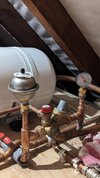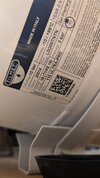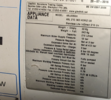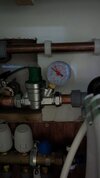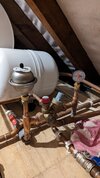Hi, hoping the wisdom of the crowd can provide some steer on what is a highly frustrating noise issue in our system going on for 6 months. After giving up with Dynorod (have homecare) I now have a someone qualified looking at it but the issue persists after numerous works.
Essentially in the morning or late afternoon when we open hot tap (any one) there is a foghorn sound.
The list of what has been done by the new engineer is below*
I have uploaded video here (15 seconds in)
Based in NW London if there is anyone local who can come over and provide another opinion (will pay for your time of course).
Thanks in advance!
*
Visit 4
We attended the above property to install a pressure reducing valve where the cold mains comes into the property. We have also installed a non return valve on the hot water pipework under the kitchen sink. This should stop the mains cold water pressure building up and getting into the hot side causing the noise.
Visit 3
We spoke with the cylinder manufacture Gledhill to see what they now suggest as the noise has returned. They asked if we have carried out the following works all which we have done already (replacement of combination valve, install shock arrestor, check expansion vessel).
They recommend the next step to take is to install a pressure reducing valve by the internal stop cock or a non return valve under the kitchen sink on the hot pipe. By doing this would mean that all the taps are under the same pressure. They feel as the kitchen tap does not go through the combination valve in the loft this can be building up more pressure from the street when none of the taps are in use and back feeding down the hot pipe for the kitchen tap and then back up to the loft.
Visit 2
We attended the above property to replace the combination valve and to install a shock arrestor on the incoming mains. We have also re-positioned the pressure gauge for the system. This should hopefully stop any noises coming from the loft area when you open a tap. We checked the external expansion vessel and this seemed to have charged so this is all o.k.
Visit 1
We attended the above property to investigate an issue with a noise when the hot water tap was on. We managed to hear this sound whilst on site.
We drained away the water from the expansion vessel and checked its pre charge. This was at 2.45 bar and the vessel requires 3 bar.
We topped this up on our pump to 3 bar and left this for 35 minutes. Whilst we had this set we also installed a pressure gauge on the combination valve.
We then removed the pump from the expansion vessel as the pressure held. We then turned the water back on and noticed that the pressure gauge was reading the right pressure passing through the combination valve.
Essentially in the morning or late afternoon when we open hot tap (any one) there is a foghorn sound.
The list of what has been done by the new engineer is below*
I have uploaded video here (15 seconds in)
Based in NW London if there is anyone local who can come over and provide another opinion (will pay for your time of course).
Thanks in advance!
*
Visit 4
We attended the above property to install a pressure reducing valve where the cold mains comes into the property. We have also installed a non return valve on the hot water pipework under the kitchen sink. This should stop the mains cold water pressure building up and getting into the hot side causing the noise.
Visit 3
We spoke with the cylinder manufacture Gledhill to see what they now suggest as the noise has returned. They asked if we have carried out the following works all which we have done already (replacement of combination valve, install shock arrestor, check expansion vessel).
They recommend the next step to take is to install a pressure reducing valve by the internal stop cock or a non return valve under the kitchen sink on the hot pipe. By doing this would mean that all the taps are under the same pressure. They feel as the kitchen tap does not go through the combination valve in the loft this can be building up more pressure from the street when none of the taps are in use and back feeding down the hot pipe for the kitchen tap and then back up to the loft.
Visit 2
We attended the above property to replace the combination valve and to install a shock arrestor on the incoming mains. We have also re-positioned the pressure gauge for the system. This should hopefully stop any noises coming from the loft area when you open a tap. We checked the external expansion vessel and this seemed to have charged so this is all o.k.
Visit 1
We attended the above property to investigate an issue with a noise when the hot water tap was on. We managed to hear this sound whilst on site.
We drained away the water from the expansion vessel and checked its pre charge. This was at 2.45 bar and the vessel requires 3 bar.
We topped this up on our pump to 3 bar and left this for 35 minutes. Whilst we had this set we also installed a pressure gauge on the combination valve.
We then removed the pump from the expansion vessel as the pressure held. We then turned the water back on and noticed that the pressure gauge was reading the right pressure passing through the combination valve.




